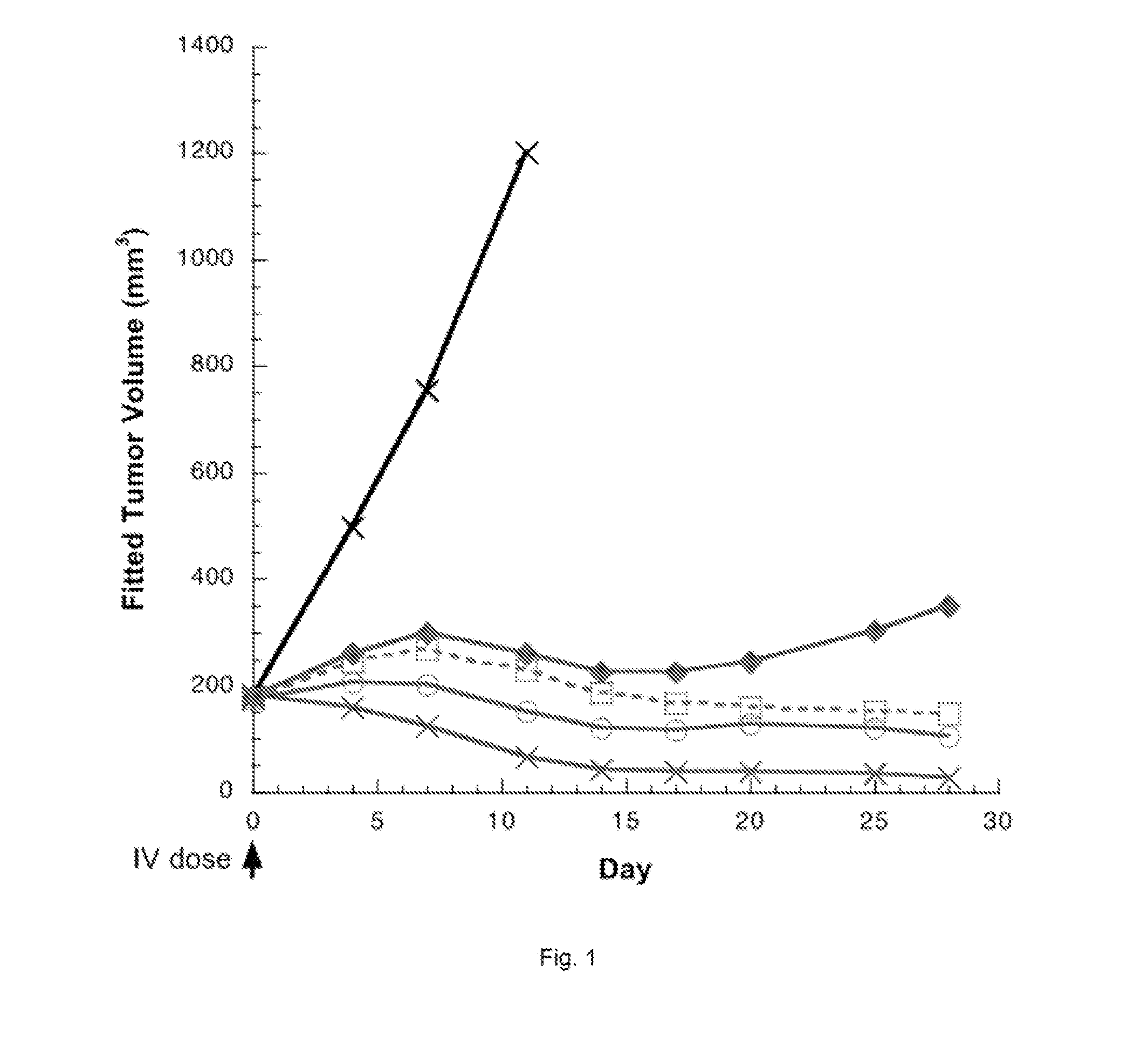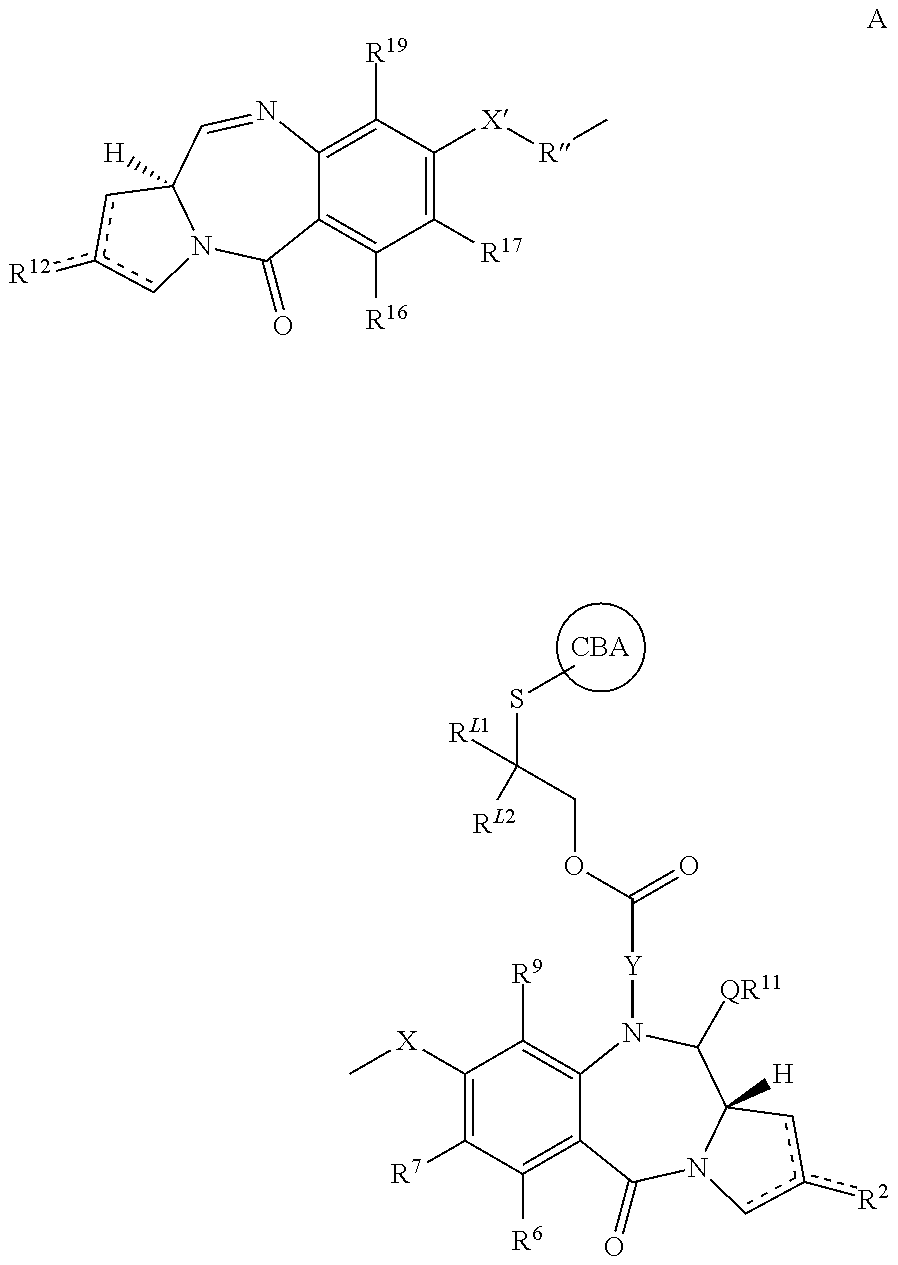Pyrrolobenzodiazepines and conjugates thereof
a technology of pyrrolobenzodiazepines and conjugates, which is applied in the field of pyrrolobenzodiazepines, can solve problems such as inacceptable levels of toxicity to normal cells
- Summary
- Abstract
- Description
- Claims
- Application Information
AI Technical Summary
Benefits of technology
Problems solved by technology
Method used
Image
Examples
example 1
(a) (S)-2-(methoxycarbonyl)-4-methylenepyrrolidinium chloride (3)
[0481]
(i) (S)-1-tert-butyl 2-methyl 4-methylenepyrrolidine-1,2-dicarboxylate (2)
[0482]Potassium carbonate (19.92 g, 14 mmol, 3 eq.) was added to a stirred solution of the carboxylic acid (1) (10.92 g, 48 mmol, 1 eq.) in DMF (270 mL). The resulting white suspension was stirred at room temperature for 30 minutes, at which point iodomethane (21.48 g, 9.5 mL, 151 mmol, 3.15 eq.) was added. The reaction mixture was allowed to stir at room temperature for 3 days. The DMF was removed by rotary evaporation under reduced pressure to afford a yellow residue which was partitioned between ethylacetate and water. The organic layer was separated and the aqueous phase was extracted with ethylacetate. The combined organic layers were washed with water, brine and dried over magnesium sulphate. The ethylacetate was removed by rotary evaporation under reduced pressure to give the crude product as a yellow oil. The crude product was purif...
example 2
[0497](a) (R)-2-(pyridin-2-yldisulfanyl)propan-1-ol (18)
(i) (R)-methyl 2-(acetylthio)propanoate (16)
[0498]Thioacetic acid (1.99 g, 1.86 mL, 26.1 mmol, 1.1 eq.) was added to a suspension of cesium carbonate (7.73 g, 23.72 mmol, 1.0 eq.) in dry DMF (40 mL). After 30 minutes (S)-methyl 2-chloropropanoate (16) was added and the mixture was allowed to stir at room temperature for 1 hour. The reaction mixture was partitioned between diethyl ether (150 mL) and water (150 mL); the water was separated and washed with a further portion of diethyl ether (150 mL). The combined organic portions were washed with water (6×100 mL), brine (200 mL), dried (MgSO4) and evaporated under reduced pressure. Purification by flash column chromatography [10% ethylacetate / 90% n-hexane] gave the product as a colourless oil (3.01 g, 82%). Analytical Data: RT 2.25 min; MS (ES+) m / z (relative intensity) 163 ([M+H]+, 10), 185([M+Na]+, 65); [α]td=[+141]17.8° C.d (c, 2.26 CHCl3).
(ii) (R)-2-mercaptopropan-1-ol (17)
[04...
example 3
Determination of in Vitro Cytotoxicity
[0507]K562 human chronic myeloid leukaemia cells were maintained in RPM1 1640 medium supplemented with 10% fetal calf serum and 2 mM glutamine at 37° C. in a humidified atmosphere containing 5% CO2 and were incubated with a specified dose of drug for 96 hours at 37° C. in the dark. The incubation was terminated by centrifugation (5 min, 300 g) and the cells were washed once with drug-free medium. Following the appropriate drug treatment, the cells were transferred to 96-well microtiter plates (104 cells per well, 8 wells per sample). Plates were then kept in the dark at 37° C. in a humidified atmosphere containing 5% CO2. The assay is based on the ability of viable cells to reduce a yellow soluble tetrazolium salt, 3-(4,5-dimethylthiazol-2-yl)-2,5-diphenyl-21-1-tetrazolium bromide (MTT, Aldrich-Sigma), to an insoluble purple formazan precipitate. Following incubation of the plates for 4 days (to allow control cells to increase in number by appro...
PUM
| Property | Measurement | Unit |
|---|---|---|
| concentration | aaaaa | aaaaa |
| concentration | aaaaa | aaaaa |
| weight | aaaaa | aaaaa |
Abstract
Description
Claims
Application Information
 Login to View More
Login to View More - R&D
- Intellectual Property
- Life Sciences
- Materials
- Tech Scout
- Unparalleled Data Quality
- Higher Quality Content
- 60% Fewer Hallucinations
Browse by: Latest US Patents, China's latest patents, Technical Efficacy Thesaurus, Application Domain, Technology Topic, Popular Technical Reports.
© 2025 PatSnap. All rights reserved.Legal|Privacy policy|Modern Slavery Act Transparency Statement|Sitemap|About US| Contact US: help@patsnap.com



